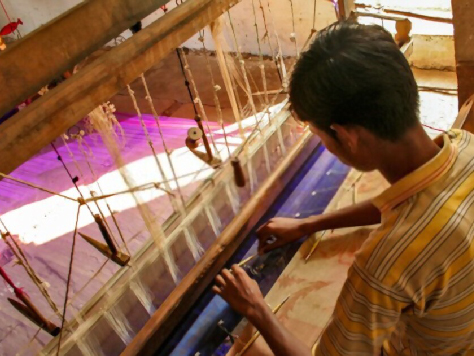We cannot talk about India without mentioning an integral part of the rich Indian heritage - Banarasi sarees. Banarasi sarees have been a fixture in the Indian woman's wardrobe since time immemorial. The beauty of these spellbinding delicacies is unparalleled even today.
They can be defined as a garment that suits every body type, accentuates every body shape, and hides flaws simultaneously. Classic banarasi silk sarees are popularly woven in the holy city of Varanasi/Banaras. They are among our country's most coveted garments and have made their mark on the world map.
Our country is famous and renowned for many things, including banarasi sarees. The sheer elegance and lustre of these delicacies are the reason why they make for a perfect pick for various formal occasions, including weddings, festive celebrations, and other events.
Made using the finest silk, these draperies are decorated with heavy gold and silver zari or brocade work, intricate embroidery, and design. Precious floral and foliate motifs, including kalga, bel and jhallar, remain a staple in these spellbinding delicacies.
[Read About Banarasi Saree Handloom Manufacturing]
Classic Banarasi Sarees - History

The sacred city of Varanasi continues to remain an epicenter of music, religion, art forms, philosophy, and various clothing items. Since the beginning of time, it has fascinated travellers and foreigners worldwide to visit the magical land and experience the richness of the Indian heritage and its beauty.
The history of quaint banarasi sarees dates back to the 14th century. It is believed that weavers from Gujarat flew during the famines and started weaving in the city. This is how Varanasi's weaving industry took birth.
In addition, when weavers from Persia flocked to the town, they began dominating the designs. Hence, many of the motifs showcased in these delicacies were inspired by Persian culture.
All in all, the classic banarasi saree that we see today is a beautiful and imperfect mixture of various influences from across the country. Also known as the Banarasi weave, it is safe to say that it has been improvising and evolving for ages.
Originally woven for royalty, the Banarasi weave was widely adorned by the men and women of royal families. Intricate silk brocade designs, gold, and silver zari work, and the richness of these draperies are why they are so popular.
Classic Banarasi Sarees - Manufacturing Process
The manufacturing process of banarasi sarees is as unique as these delicacies themselves. Banarasi sarees derived their name from the city itself - Banaras. But, did you know Banaras is one of the oldest living cities in this world? The city is beautiful, welcoming, and has a place for everyone.
Located on the banks of the holy river Ganges, the area attracts people from all over the globe. For ages, travellers and foreigners have been yearning to explore this bustling yet charming town.
Let us now jump to see how these spellbinding sarees are woven.
- The first step in the manufacturing process entails the clubbing of yarns in a format to form a fabric. The clubbing of yarns in an arrangement is known as weaving.
- The selection of yarns is another essential part of the process. Silk yarns are procured for the production of banarasi sarees. These yarns are available in varied qualities.
- The dyeing of yarns is the next step. As simple as it sounds, it is a unique step in the production process. The silk yarns can be dyed in the colour of your choice. This entails boiling water in a big pot and adding the desired colour. Once the required temperature is attained, the silk yarn is dipped in this pot rotationally to ensure proper and equal colour soaking over the fabric. Once the dyeing process is complete, the yarns' rods are twisted to get rid of excess water. They are then stretched out in the sun for drying.
- The next step, i.e., the reeling process, entails an operator manually operating the reeling machine. The operator inserts threads of hangs from one end, and a single thread is produced from the other. This output is then wrapped over reels and cones.
- The process of designing is next in line. Banarasi sarees are famous for their design all over the world. The beauty of these tasteful designs and artwork is unmatched. These designs are drawn on paper and then copied on graph paper. These designs are hand-punched on stencils made of cardboard, also known as jacquard cards. Jacquard cards or the naksha patta help draw designs on fabrics and are essential to the process.
- The last step in the process is weaving. With the help of the warp and weft technique, banarasi saree weavers in Varanasi produce banarasi sarees. With jacquard cards, the designs are incorporated and attached to the machine. Warp (tana) is the longitudinal thread, and weft (bana) is the latitudinal thread. They are set on the loom along with the jacquard cards—the back-and-forth movement of the shuttle and the carrying out of desired design complete the process.
With the last step, the production process of a banarasi saree in Varanasi ends. These delicacies have been here since the beginning of time; as discovered above, they constantly evolve.
The banarasi sarees we wear today are a beautiful combination of years of improvisation, evolution, and diverse influences. They are a massive part of our Indian heritage and should always remain as long as we do not leave them behind. Albeli is one the best manufacturers of Banarasi silk Sarees, you can contact them or directly visit their banarasi silk saree store in Varanasi to buy banarasi silk sarees at reasonable rates.
Final Thoughts
Banarasi sarees make our rich Indian culture richer. Birthed in the humble city of Varanasi, they are our country’s true pride. Not only adored and admired across our country, but they have also successfully left an indelible mark on the world map.
People across the globe love adorning these draperies for various festive celebrations, wedding festivities, and other functions. The refined elegance that it adds to any overall appearance is truly eye-catching. Every banarasi saree tells a different tale. However, they all have one thing in common - their roots in Varanasi.



.webp)


Comments
Leave A Comment: